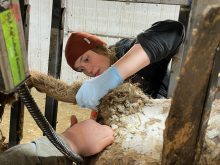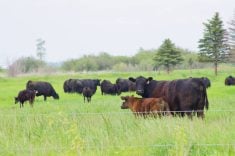I recently attended the Vaccine and Infectious Disease Organization’s Animal Health Summit.
The conference provided veterinarians, producers and other industry stakeholders an update on the current status of foot and mouth disease (FMD) worldwide.
VIDO was founded more than 45 years ago at the University of Saskatchewan and is a leader in infectious disease research and vaccine development for humans and animals.
Canada has been fortunate in not having had FMD since an outbreak occurred in 1951 and 1952 in Saskatchewan.
FMD is caused by a virus and it is extremely contagious.
Read Also

Manitoba extends Crown land rent freeze
Manitoba government links the continued rental rate freeze on grazing and forage leases to economic and environmental challenges facing the industry
The virus is spread in the saliva, milk, or semen of infected animals but is mainly excreted in aerosol form in respiratory secretions. It can be spread through the introduction of infected animals, contaminated vehicles, feed, clothing, footwear or equipment. It is also possible to be spread via infected meat or contaminated animal products (if fed to animals) and can spread significant distances via wind currents.
In addition, the FMD virus has seven different strains worldwide. Each strain requires a specific vaccine to provide protection.
FMD can infect cattle, pigs, sheep and goats along with many wild animals. The disease is only carried by cloven-hoofed animals and does not infect humans.
The most common clinical signs of FMD are blisters or vesicles that appear on the mouth, tongue, muzzle, teats and feet of animals. These blisters burst and leave painful sores.
In younger animals, the virus can cause death because it can affect the heart. In older animals, the virus causes a dramatic decrease in the animal’s productivity and growth.
There is no treatment for FMD and although vaccines are available, they are only used in certain outbreaks and the specific vaccine for the particular strain of the virus needs to be used. The use of vaccines has implications for international trade and can affect a country’s disease-free status.
Several of the speakers at the VIDO animal health summit were veterinarians and researchers from the United Kingdom, where two outbreaks of FMD occurred in 2001 and 2007.
The larger 2001 outbreak had a massive impact on British agriculture and tourism. The U.K. relied heavily on segregating and culling infected animals and herds to stop the disease spread. That outbreak lasted 221 days and a staggering total of 6.5 million animals were culled across 44 British counties.
The speakers emphasized the enormous resources it took to deal with the outbreak, including 2,000 veterinarians, 7,000 administrators and technical staff, and 2,000 military personnel.
The disease spread so quickly that immediate surge capacity was needed for all of those personnel. The total cost of the outbreak was estimated at approximately five billion pounds sterling (C$8.5 billion in today’s dollars.)
A key message for the audience at the summit was that the FMD virus is spreading at unprecedented speed in many parts of the world and that genetic fingerprinting tools can help researchers understand how the disease moves.
As well, the U.K. outbreaks showed the importance of markets in the spread of disease. In the 2001 outbreak, six different markets were directly involved, which allowed the silent spread of disease to multiple areas of the country before the disease was detected. Identification systems and traceability are key components of being prepared for the next outbreak.
Another key lesson from the U.K. outbreaks was the importance of early reporting and rapid response. This comes down to local farmers and veterinarians being able to recognize and report the clinical signs of FMD as soon as they are suspicious.
Early detection and response can make a huge difference in how far an outbreak can spread before disease control measures can be put in place. This will have a major impact on the size of the outbreak and the time necessary to control it.
I encourage readers to visit the Animal Health Emergency Management Project at https://animalhealthca/disease-response. The Canadian Animal Health Surveillance System has brought together information on a wide range of reportable diseases and provides resources and free training on preparedness for foot and mouth disease for producers.
Their resources on biosecurity, emergency preparedness and mental health are important for us to consider, making sure we are ready for an animal disease emergency such as foot and mouth disease in the future.
John Campbell is a professor in the department of Large Animal Clinical Sciences at the University of Saskatchewan’s Western College of Veterinary Medicine.















